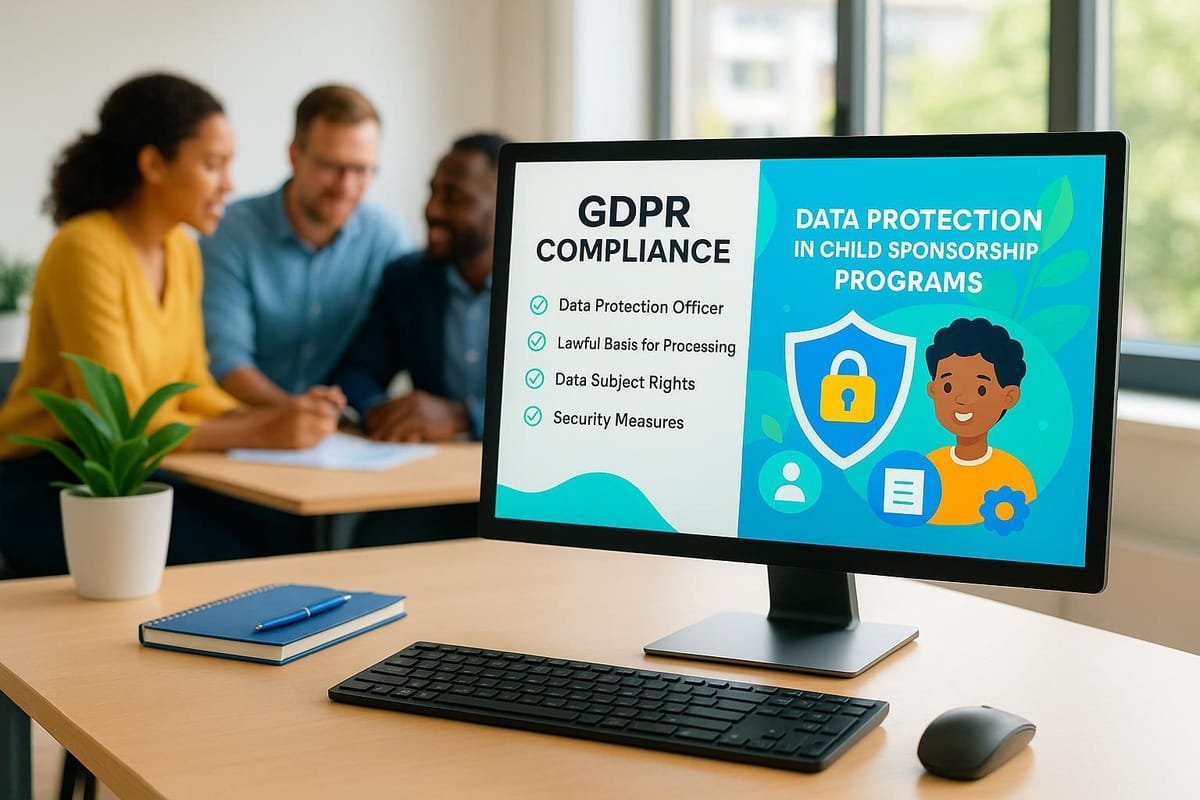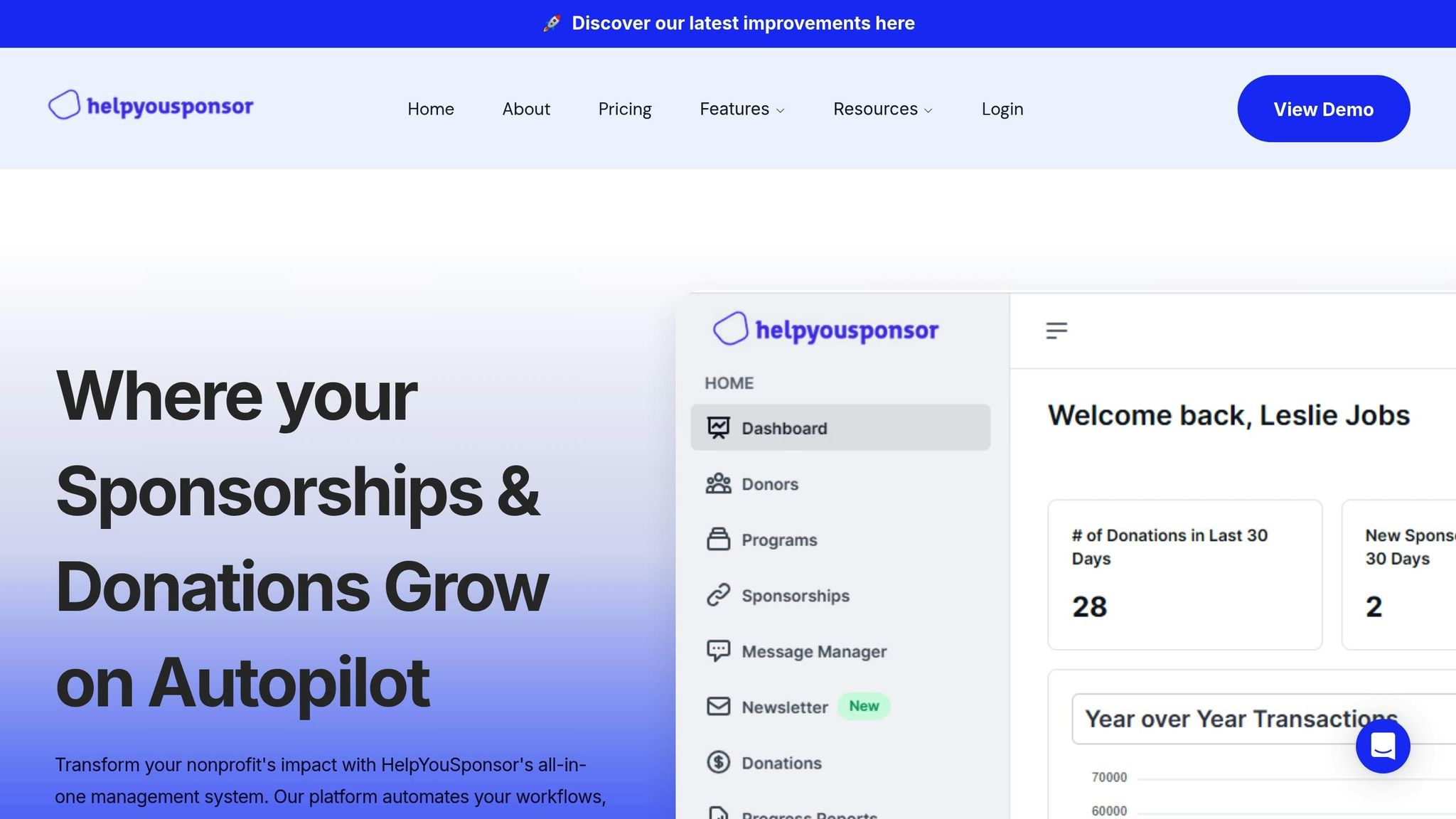GDPR Compliance for Child Sponsorship Programs
Ensure GDPR compliance in child sponsorship programs with data protection practices that build trust and safeguard sensitive information.

GDPR compliance is critical for child sponsorship programs to protect sensitive data and build trust with families and donors. Here's what you need to know:
- GDPR Overview: The regulation governs how personal data is collected, processed, and stored, with stricter rules for children's data. Consent is required, typically from parents, with the age of consent varying between 13 and 16 across EU countries.
- Why It Matters: Non-compliance can lead to fines up to €20 million or 4% of annual revenue. Beyond fines, it ensures data protection, transparency, and trust.
-
Key Requirements:
- Collect only necessary data (data minimization).
- Be transparent about data use.
- Maintain strong security and accountability measures.
-
HelpYouSponsor Tools:
- Consent management system for parental permissions.
- Customizable forms to limit data collection.
- Role-based access controls and encryption for data security.
-
Best Practices:
- Regular staff training to prevent data breaches.
- Document all compliance efforts, like consent forms and data processing activities.
- Test and update incident response plans regularly.
- Conduct audits and update policies to align with current regulations.
Getting started with GDPR compliance: Consent
Key GDPR Requirements for Child Sponsorship Organizations
For child sponsorship programs, understanding and adhering to GDPR requirements is crucial. These rules not only help safeguard personal data but also foster trust among families and communities.
Data Minimization and Purpose Limitation
GDPR emphasizes that personal data should be "adequate, relevant, and limited to what is necessary" for the specific purposes it is collected. In simpler terms, organizations should only gather data that serves a clear, legitimate purpose - and they can't use it for anything outside of that purpose.
To put this into practice, organizations should start with data mapping. This involves creating a detailed inventory of all personal data collected, processed, and stored. From there:
- Clearly define and document why the data is being collected.
- Regularly review data to ensure it remains necessary and relevant.
- Set up a retention schedule to outline how long different types of data will be stored.
Transparency, Accountability, and Security
Once data collection is limited, the next step is ensuring clarity and control. Transparency means providing individuals with clear, easy-to-understand information about how their data is used. This is often done through accessible privacy policies.
Accountability goes a step further, requiring organizations to prove they comply with GDPR principles. One effective way to achieve this is by embedding privacy by design and by default into all new products, services, and processes from the beginning.
Security is also key. Organizations must implement strong measures to protect the confidentiality and integrity of personal data. This includes regularly updating privacy policies and security protocols to ensure compliance efforts remain effective over time.
Using HelpYouSponsor for GDPR Compliance

HelpYouSponsor offers practical tools to help organizations navigate the complexities of GDPR compliance, particularly when handling children's data in sponsorship programs. By integrating user-friendly features, the platform simplifies what can often feel like an overwhelming process.
Streamlined Consent Management
When it comes to GDPR compliance, obtaining valid consent is non-negotiable - especially for child sponsorship programs that require parental approval for processing children's data.
HelpYouSponsor's consent management system takes the guesswork out of this process. It automatically generates GDPR-compliant consent forms, ensuring they meet the strict standards of being freely given, specific, informed, and unambiguous. The platform also allows parents to customize their consent preferences. For instance, they can agree to the collection of basic contact information but decline photo sharing. Each consent entry is securely timestamped and stored, and if parents choose to withdraw consent later, the system makes it just as easy to reverse as it was to provide.
This seamless consent process lays a strong foundation for adhering to other GDPR principles, such as data minimization and security.
Ensuring Data Minimization
GDPR emphasizes collecting only the data you truly need, and HelpYouSponsor’s custom form builder is designed with this principle in mind. Instead of gathering every piece of information available, the platform encourages organizations to focus on what’s essential for their sponsorship programs. This not only reduces risk but also aligns with GDPR’s requirement for purpose limitation.
As your program evolves, you can revisit and adjust your data collection practices to ensure ongoing compliance. This flexibility helps keep your processes efficient and compliant without unnecessary data collection.
Data Security and Access Controls
Protecting sensitive data - especially when it involves children - requires strong security measures, and HelpYouSponsor delivers on this front. The platform uses role-based access controls to ensure that only authorized personnel can view or manage specific types of information. For example, volunteers might only access basic details, while financial staff handle donation records.
To enhance accountability, the system keeps detailed audit trails that track data access. Additionally, industry-standard encryption and automated backups safeguard all stored information. These measures not only protect personal data but also help organizations respond quickly and effectively if an issue arises, ensuring compliance with GDPR’s stringent security requirements.
Together, these features create a secure and streamlined approach to managing children's data responsibly.
Best Practices for Maintaining GDPR Compliance
Adhering to GDPR standards is not just about avoiding hefty penalties - up to €20 million or 4% of annual revenue for violations - but also about building trust with donors and the families participating in sponsorship programs. This is especially critical when handling sensitive information, such as children's data. With HelpYouSponsor offering guidance, these practices can help ensure ongoing compliance and maintain that trust.
Regular Training and Awareness
Did you know that human error is responsible for up to 90% of data breaches? That’s why training your staff is one of the most effective ways to safeguard against GDPR violations. Proper education transforms potential vulnerabilities into strengths when it comes to data protection.
But don’t stop at annual training sessions. GDPR compliance requires continuous learning. Staff need to understand core principles like data minimization, how to process data subject rights requests, and the specifics of handling sensitive data - especially in child sponsorship programs where personal details about minors and their families are frequently accessed.
"Strong data protection practices start with your people. GDPR training empowers your staff to work responsibly, supports compliance goals, and helps reduce the risk of breaches and enforcement action." - Harper James
Tailor training to specific roles. For instance, a volunteer processing sponsorship applications will need different guidance compared to a financial officer managing donation records. Use real-world scenarios to make training practical. For example, walk through how to handle a parent's request to review all data collected about their child or how to respond when a sponsor asks to share photos of a child on social media.
Stay up to date with regulatory changes. GDPR interpretations evolve, so it’s essential to schedule quarterly refresher sessions and have a system in place to share updates with staff promptly. These steps not only strengthen compliance but also enhance your record-keeping and incident response capabilities.
Record-Keeping and Incident Response Planning
Keeping detailed records is more than just a box-ticking exercise - it’s your proof of compliance and a guide for navigating potential issues. Make sure to document every step of your GDPR compliance efforts, from consent forms to staff training completion and data subject requests.
Key areas to document include:
- Consent forms, especially for parental permissions.
- Data processing activities and any restrictions placed by families.
- Photo usage permissions and related agreements.
Equally important is having a robust incident response plan. This plan should clearly define roles, such as who leads the response, handles IT forensics, manages legal obligations, and communicates with affected families.
Here’s a quick snapshot of an effective incident response timeline:
| Response Phase | Actions | Timeline |
|---|---|---|
| Detection | Identify and escalate incidents immediately | Within hours |
| Containment | Isolate threats and minimize damage | Within 24 hours |
| Notification | Inform supervisory authorities and individuals | Within 72 hours (authorities), ASAP for high-risk cases |
| Remediation | Address vulnerabilities and prevent recurrence | Ongoing |
Regularly test your incident response plan with scenarios tailored to child sponsorship programs. For example, practice responding to unauthorized access to children's photos or accidental disclosure of family contact information. By testing these processes, you’ll be better prepared to handle real-world challenges.
Monitoring and Policy Updates
GDPR compliance isn’t a one-and-done task - it requires constant vigilance. Regularly review your data protection policies and practices to ensure they align with current operations and regulatory requirements. What worked last year might no longer be sufficient.
Schedule quarterly audits of your data collection processes. Ask yourself:
- Are we still collecting only the data we truly need?
- Have our consent forms been updated to reflect new activities or programs?
- Are our data retention policies appropriate for our current operations?
Stay informed about changes in GDPR regulations, both locally and internationally. Consider subscribing to updates from data protection authorities and relevant industry groups to ensure you’re aware of any shifts in guidance or enforcement priorities.
Transparency is key. Regularly update your privacy policies so that parents and sponsors can easily understand how their data is being used - no legal jargon required. Make data protection part of your organization’s culture by weaving it into your mission and values. Celebrate staff who excel in compliance practices and make data protection a standing topic in team meetings. By doing so, you’ll create an environment where vigilance is second nature.
Achieving GDPR Compliance with Confidence
Building on strong GDPR practices doesn't just protect data - it strengthens your organization's foundation. By ensuring compliance, you secure trust and reinforce your mission. When you handle children's data responsibly, you show families, sponsors, and donors that privacy is just as important to you as the cause itself.
Start with a thorough data audit to map out how information flows through your organization. This initial step uncovers gaps in your current processes and provides a clear path forward for meeting compliance standards.
Organizations that prioritize data protection often experience smoother operations. For instance, automated compliance tools have been shown to significantly cut down on manual processing time. Even if your child sponsorship program operates on a smaller scale, adopting smart compliance strategies can streamline your efforts. Efficient systems not only save time but also build trust with donors and families.
Data privacy is a trust-builder. Research indicates that 94% of consumers prefer companies that put data protection first. For child sponsorship programs, this translates directly into greater confidence - parents feel reassured about their children's privacy, and sponsors appreciate transparency in data handling.
Platforms like HelpYouSponsor, designed specifically for sponsorship programs, make GDPR compliance easier. It includes built-in features such as consent management tools, data minimization options, and secure access permissions. These tools allow you to focus on connecting sponsors with children while compliance is seamlessly managed in the background.
"GDPR compliance is not just a way to steer clear of fines but a strategic advantage. It positions your business as forward-thinking and responsible, gaining customer trust, improving security, and streamlining operations." - Safna
Compliance isn't a one-and-done task - it’s an ongoing responsibility. As regulations change, your data practices must evolve too. Consistent staff training, clear policies, and dependable systems are essential for long-term success.
Whether you're managing a handful of sponsorships or hundreds, GDPR compliance ensures every child's privacy is protected and donor confidence is strengthened. The principles are straightforward: collect only what’s necessary, secure the data you hold, and maintain transparency in your practices. With the right tools and mindset, compliance becomes a seamless part of your operations, not a hurdle to overcome.
FAQs
How does HelpYouSponsor handle parental consent for children's data to comply with GDPR?
HelpYouSponsor takes GDPR compliance seriously, especially when it comes to handling children's data. The platform has established thorough processes to obtain and manage parental consent, as required by GDPR Article 8, for children under 13. This ensures that any data collection or processing is backed by explicit approval from a parent or legal guardian.
These measures include verifying parental responsibility and making sure that consent is informed, voluntary, and properly documented before any minor's data is managed. By focusing on these precautions, HelpYouSponsor supports organizations in building trust and staying aligned with regulatory standards.
What challenges do child sponsorship programs face with GDPR compliance, and how can they overcome them?
Child sponsorship programs face hurdles when it comes to GDPR compliance. Key challenges include obtaining valid parental consent, securely handling sensitive personal data of children, and ensuring clear communication about how this data is collected and used. The stakes are high given the delicate nature of children's information.
To navigate these challenges, organizations should adopt age-appropriate consent mechanisms, as specified in GDPR's Article 8. It's also crucial to implement strong data security measures and provide clear explanations about how data will be utilized. Training staff on GDPR requirements and adhering to data minimization principles - only gathering the data that's absolutely necessary - can further reduce risks. These efforts not only protect children's information but also strengthen trust with both families and donors.
Why is limiting data collection important in child sponsorship programs, and how can organizations ensure compliance?
Limiting the amount of data collected, often referred to as data minimization, plays a critical role in child sponsorship programs. It helps protect sensitive information about children while lowering the chances of data breaches. Plus, it ensures that organizations comply with legal frameworks like GDPR.
Here’s how organizations can approach this:
- Gather only the data absolutely necessary to manage sponsorships and achieve program objectives.
- Conduct regular reviews of data collection methods to remove outdated or irrelevant information.
- Use secure methods for storing and handling all collected data.
By prioritizing data minimization, organizations can better safeguard privacy, simplify their processes, and strengthen trust with both sponsors and the children they aim to support.

